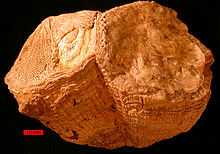Macrofossil
| Part of a series on |
| Paleontology |
|---|
 |
|
Fossils Fossilization · Trace fossil · Index fossil · List of fossils · List of fossil sites · Lagerstätte fossil beds · List of transitional fossils · List of human evolution fossils |
|
Natural history Biogeography · Extinction event · Geochronology · Geologic time scale · Geologic record · History of life · Origin of life · Timeline of evolution · Transitional fossil |
|
Organs and processes Avian flight · Cells · Multicells · Eyes · Flagella · Hair · Mammalian auditory ossicles · Mosaic evolution · Nervous systems · Sex |
|
Evolution |
|
History of paleontology |
|
Branches of paleontology Biostratigraphy · Ichnology · Invertebrate paleontology · Micropaleontology · Palaeoxylology · Paleobiology · Paleobotany · Paleoecology · Paleogenetics · Paleolimnology · Paleopedology · Paleotempestology · Paleozoology · Palynology · Sclerochronology · Taphonomy · Vertebrate paleontology |
|
Paleontology Portal Category |
Macrofossils (occasionally spelled "macro-fossil") are preserved organic remains large enough to be visible without a microscope. Most fossils discussed in the article Fossil are macrofossils. The term macrofossil stands in opposition to the term microfossil (a.k.a. "micro-fossil"). Microfossils, by contrast, require substantial magnification for evaluation by fossil-hunters or professional paleontologists. As a result, most fossils observed in the field and most "museum-quality" specimens are macrofossils.
Varities
Plant macrofossils
Plant macrofossils include leaf, needle, cone, and stem debris; and can be used to identify types of plants formerly growing in the area. Such botanical macrofossil data provide a valuable complement to pollen and faunal data that can be used to reconstruct the prehistoric terrestrial environment. Algal macrofossils (for instance, brown kelp, sea lettuce and large stromatolites) are increasingly used to analyze prehistoric marine and aquatic ecosystems.
Animal macrofossils
Animal macrofossils include the teeth, skulls, and bones of vertebrates, as well as such invertebrate remains as shells, tests, faunal armor, and exoskeletons. Fossilized dung (that is, coprolites) are also macrofossils.
Image gallery
-

Eocene fossil fish Priscacara liops from the Green River Formation of Utah.
-

Rudist bivalves from the Cretaceous of the Omani Mountains, United Arab Emirates. Scale bar is 10 mm.
